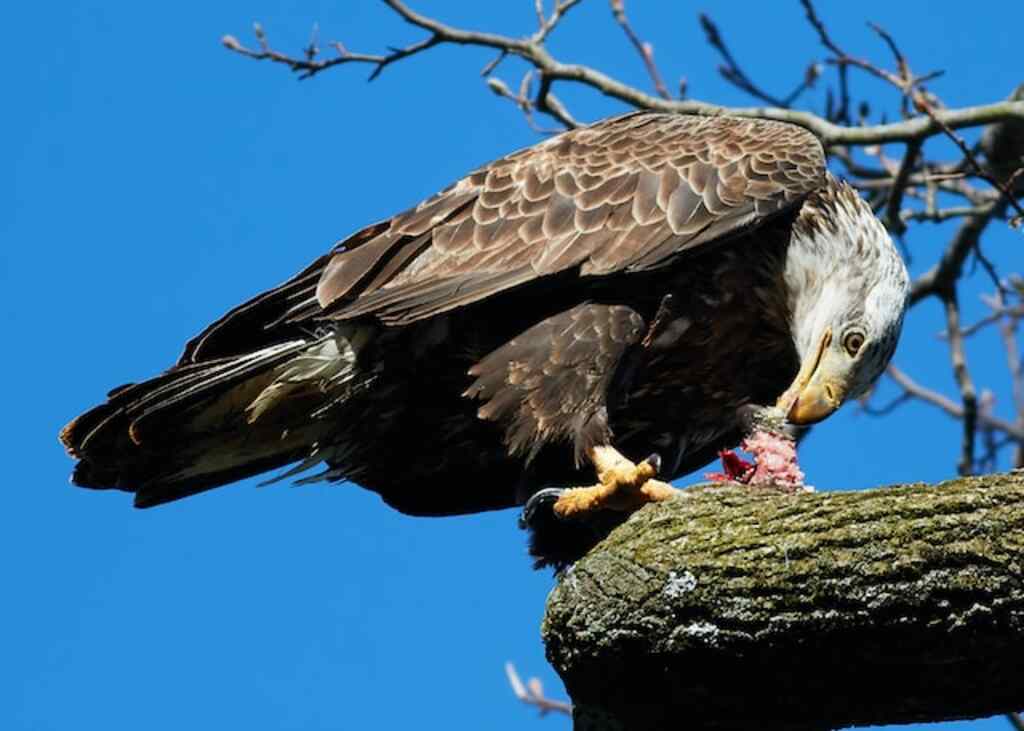Have you ever wondered about the feeding habits of eagles? Do eagles eat dead animals? These majestic birds of prey have long been admired for their hunting prowess and ability to snatch live prey from the ground or air.
However, eagles are not solely dependent on live prey for their sustenance.
In fact, they are known to scavenge on carrion, or dead animals, as well. This article aims to explore the diet of eagles, focusing on their scavenging habits and the importance of carrion in their diets.
Additionally, we will discuss the nutritional benefits of consuming dead animals, the role of carrion in the ecosystem, and the various factors that influence eagle feeding behaviors.
By understanding the feeding behaviors of eagles, we can gain a deeper appreciation for these magnificent birds and their vital role in maintaining the balance of nature.
Table of Contents [show]
Key Takeaways
- Eagles are not solely dependent on live prey and also scavenge on carrion.
- Consuming carrion helps eagles access nutrient-rich organs and muscle tissues.
- Eagles help prevent the spread of diseases by consuming carrion.
- Eagles reduce energy expenditure by scavenging on already available food sources.

Do Eagles Eat Dead Animals
Yes, eagles eat dead animals. While they primarily hunt live prey, they also scavenge on carrion when available. Carrion serves as an additional food source for eagles, especially during times when hunting is challenging or when they come across deceased animals.
The Diet of Eagles
Eagles primarily feed on carrion, playing a crucial role in the ecosystem by efficiently disposing of dead animals and contributing to the overall balance of nature.
Their diet adaptations allow them to thrive on carcasses, making them an important part of the scavenging community.
Carrion consumption is a unique feature of eagles, as they possess specialized beaks and talons that enable them to tear and grip the tough flesh of dead animals.
These adaptations allow them to access the nutrient-rich organs and muscle tissue that would otherwise be inaccessible to most other predators.
By consuming carrion, eagles help prevent the spread of diseases that may be harbored by decomposing carcasses.
Transitioning to the subsequent section, the scavenging habits of eagles reveal the intricate strategies they employ to find and access carcasses in their environment.
Scavenging Habits of Eagles
Carnivorous scavengers, these majestic birds of prey display intriguing feeding behaviors that captivate researchers and nature enthusiasts alike. Eagle scavenging behavior plays a significant ecological role, as they often feed on carrion.
While eagles are primarily known for hunting live prey, they are opportunistic feeders and readily consume dead animals.
Scavenging allows them to take advantage of already available food sources, reducing the energy expenditure required for hunting.
Additionally, by feeding on carrion, eagles contribute to the decomposition process, aiding in nutrient recycling and maintaining ecosystem balance.
They help prevent the spread of disease by consuming carcasses that might otherwise attract scavengers such as vultures or feral dogs.
Understanding the importance of carrion in eagle diets provides valuable insights into their feeding strategies and ecological impact.
Importance of Carrion in Eagle Diets
A significant aspect of the scavenging habits of eagles lies in their ability to capitalize on existing food sources, such as carrion, which not only reduces their hunting efforts but also contributes to the ecological balance of their ecosystems.
Carrion consumption benefits eagles in multiple ways. Firstly, consuming dead animals provides a readily available and abundant food source.
This is particularly important during periods of food scarcity or when live prey is difficult to find.
Additionally, carrion consumption helps to prevent the spread of diseases by removing carcasses from the environment.
Furthermore, eagles play a crucial ecological role by acting as nature’s cleanup crew, efficiently recycling nutrients from the dead animals back into the ecosystem.
This process helps maintain the balance of nutrients in the environment. Transitioning to the subsequent section about live prey hunting techniques, eagles employ various strategies to capture live prey.

Live Prey Hunting Techniques
Predatory birds, such as eagles, employ a range of highly developed techniques when hunting live prey. These strategies allow them to effectively capture and secure their food sources.
One common technique used by eagles is called perch hunting, where they perch on a high vantage point and observe their surroundings for potential prey.
Once a suitable target is spotted, eagles swiftly dive to catch their prey with their sharp talons.
Another hunting technique utilized by eagles is called soaring hunting. This involves flying above open areas, using their excellent eyesight to spot prey from a distance.
They then descend rapidly to seize their unsuspecting target. Eagles are also known to engage in cooperative hunting, where they work together to capture larger prey.
These live prey hunting strategies demonstrate the agility, speed, and adaptability of eagles in securing their meals.
Moving on to the subsequent section about the nutritional benefits of consuming dead animals…
Nutritional Benefits of Consuming Dead Animals
One fascinating statistic reveals that the consumption of carrion offers predatory birds like eagles a rich and diverse array of essential nutrients.
Carrion consumption provides numerous benefits for these birds, including access to high-quality proteins, fats, and minerals.
This is particularly important for eagles, as they require a nutrient-rich diet to support their high-energy lifestyles.
Additionally, scavenging on dead animals reduces competition for live prey and allows eagles to conserve energy by avoiding the need for active hunting.
Furthermore, the environmental impact of scavenging is noteworthy.
By consuming carrion, eagles contribute to the efficient recycling of nutrients in their ecosystem, promoting a healthy balance within the food chain.
Transitioning to the subsequent section on adaptations for scavenging, it is remarkable how eagles have evolved to exploit this valuable food source.
Adaptations for Scavenging
Scavenging on carrion has led to the development of specific adaptations in eagles, allowing them to efficiently exploit this valuable food source. These adaptations include:
- Enhanced olfactory capabilities: Eagles have a highly developed sense of smell, enabling them to detect carrion from long distances. This adaptation helps them locate food sources more effectively.
- Powerful beaks: Eagles possess strong, hooked beaks that are well-suited for tearing into tough flesh and breaking bones. This adaptation allows them to access the nutrient-rich tissues of carcasses.
- Large size and strong flight muscles: Eagles are large birds with robust flight muscles, which enable them to carry and transport relatively heavy prey items over long distances. This adaptation allows them to scavenge on carrion in various locations.
By employing these scavenging adaptations and employing various foraging strategies, eagles are able to capitalize on the abundance of dead animals, ensuring their survival and success. This highlights the crucial role of scavenging in their ecological niche.

Role of Carrion in the Ecosystem
Despite their reputation as majestic hunters, eagles play a crucial and often overlooked role in the ecosystem by consuming carrion, which inadvertently contributes to the recycling of nutrients and the overall balance of the environment.
Carrion, or dead animal matter, is an important source of food for eagles, especially during times when prey is scarce.
As eagles scavenge on carrion, they help to break down the carcasses and facilitate the process of carrion decomposition.
This decomposition releases essential nutrients back into the environment, which can then be utilized by other organisms.
Additionally, by consuming carrion, eagles help to prevent the spread of diseases that may be present in the decaying animals.
Overall, the ecological role of carrion-eating eagles is vital in maintaining the health and sustainability of the ecosystem.
Moving forward, it is important to understand the factors influencing eagle feeding behaviors to gain a comprehensive understanding of their role in the ecosystem.
Factors Influencing Eagle Feeding Behaviors
Factors such as environmental conditions and prey availability significantly influence the feeding behaviors of eagles, shaping their role in the ecosystem.
Eagles are opportunistic predators that primarily feed on live prey, but they are also known to scavenge on carrion, including dead animals.
However, the extent to which eagles rely on carrion varies, depending on various factors.
The influence of competition plays a crucial role in determining eagle feeding behaviors.
When live prey is scarce or when competition for food is high, eagles may resort to scavenging on dead animals as an alternative food source.
This can have a significant impact on the local wildlife, as the presence of eagles scavenging on carrion can influence the dynamics of other scavengers and predators in the ecosystem.
Understanding these factors is important for conservation efforts, as it helps in assessing the overall impact of eagles on the ecosystem and implementing appropriate management strategies to ensure the balance of the ecosystem.
Transitioning into the subsequent section about conservation implications, it is crucial to consider the role of eagles in the ecosystem and their interactions with other wildlife.
Conservation Implications
The conservation implications of eagle feeding behaviors extend beyond their role as opportunistic predators and have broader implications for the dynamics of the ecosystem and the interactions among wildlife.
Understanding the ecological impact of eagle feeding behaviors is crucial for designing effective conservation strategies.
It is important to recognize that eagles play a vital role in maintaining the balance of ecosystems by regulating populations of prey species.
Their feeding behaviors, such as scavenging on dead animals, contribute to nutrient recycling and help prevent the spread of diseases.
Additionally, the presence of eagles in an ecosystem can influence the behavior and distribution of other wildlife species.
By studying the feeding behaviors of eagles and their ecological impact, conservationists can develop targeted management plans to ensure the long-term survival of these majestic birds and the biodiversity of their habitats.
Transitioning into the subsequent section about misconceptions about eagle diets, it is necessary to address certain misconceptions surrounding their feeding habits.

Misconceptions about Eagle Diets
One common misconception about the diets of eagles is that they primarily consume live prey, while in reality, their feeding behaviors are much more diverse and varied.
Eagles are opportunistic predators that are capable of scavenging and feeding on dead animals. They are known to consume carrion, which includes dead fish, mammals, and birds.
While live prey such as fish and small mammals make up a significant portion of their diet, eagles also take advantage of available food sources, including carcasses.
This misconception may arise from the impressive hunting and fishing skills that eagles possess, but it is important to recognize that they are not solely reliant on live prey.
The table below summarizes common myths and dietary misconceptions about eagles.
| Myth | Reality |
|---|---|
| Eagles only eat live prey | Eagles are opportunistic and feed on carrion |
| Eagles primarily consume fish | Eagles have a diverse diet, including mammals and birds |
| Eagles do not scavenge | Eagles scavenge and feed on dead animals when available |
| Eagles need to hunt daily for food | Eagles can go several days without eating |
| Eagles do not eat plant matter | Eagles occasionally consume plant material, such as fruits |
Overall, it is important to dispel these misconceptions and recognize the adaptability of eagles in their feeding behaviors. By understanding their diverse diet, we can better appreciate the ecological role that eagles play in maintaining the balance of ecosystems.

Frequently Asked Questions
How do eagles locate carrion from long distances?
Eagles employ various scavenging techniques to locate carrion from long distances. These include soaring at high altitudes to scan large areas, keen eyesight to spot potential food sources, and following the scavenging behavior observed in other bird species.
Can eagles survive solely on a diet of dead animals?
Eagles, as apex predators, can survive on a diet of dead animals, known as carrion. While carrion lacks the freshness and nutritional value of live prey, eagles have adapted to extract the necessary nutrients from such food sources.
Do eagles have a preference for certain types of carrion?
Eagle scavenging behavior and carrion selection by eagles depend on various factors, such as habitat, prey availability, and competition. They may show a preference for certain types of carrion based on nutritional value and ease of access.
Are there any risks or diseases associated with consuming dead animals?
There are risks of food contamination and potential impact on eagle population dynamics associated with consuming dead animals. These risks include the transmission of diseases and parasites, as well as the potential accumulation of toxins in the food chain.
What are some unique adaptations that allow eagles to scavenge effectively?
To scavenge effectively, eagles have unique adaptations such as their sharp beaks for tearing flesh and strong talons for gripping prey. They can learn scavenging techniques from other bird species, but the impact of scavenging behavior on eagle populations is not well understood.
Conclusion
In conclusion, the diet of eagles is diverse and includes both live prey and carrion. While they are skilled hunters, eagles also rely on scavenging for sustenance.
The consumption of dead animals provides important nutritional benefits to eagles and plays a crucial role in the ecosystem.
Factors such as availability of carrion and competition influence their feeding behaviors.
It is essential to understand and preserve the feeding habits of eagles for conservation purposes. Contrary to misconceptions, eagles play a vital role in maintaining the balance of nature’s intricate web.



